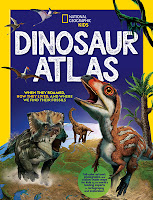

It's
Marvelous Middle Grade Monday
at
at
and #IMWAYR day
at
and
National Geographic Kids. The Dinosaur Atlas
September 20th 2022 by National Geographic Kids
Copy provided by Media Masters Publicity
The subtitle of this oversize (10.5" x 14") book tells it all: When they roamed, how they lived, and where we find their fossils! Even the table of contents of this book is beautifully formatted and lays out what we will find inside; a brief discussion of dinosaurs and their times, explanations of the habitats, dinosaurs, and life of the Triassic , Jurassi, and Cretaceous periods, and then examples of dinosaur fossils found on six continents. There's even a little bit about what happened to the dinosaurs and what creatures are descended from them.
The real draw of National Geographic books is usually the gorgeous photographs; since we are dealing with time periods well before photography, we get instead excellent illustrations of the animals and their habitats. These are done in such a convincing way that I had to look closely at some of the smaller, inset pictures to tell whether or not they were photographs of modern animals! I'm not sure how illustrator Franco Tempesta created these small works of art, but they are quite impressive, not to mention a little bit scary! There are some occasional photographs, such as the skeleton of a tiny Early Jurassic Hadrocodium or modern scientists like Jack Horner.
Professor Steve Brusatte, a paleotologist, seems to have written most of the text, which fills the pages with trivia that will delight even the most avid dinosaur fan. I really enjoyed the tour of the continents and the dinosaurs that were found in different locations; there are excellent maps showing where these were found, as well as discussions of the areas as well as the civilians and scientists who discovered the fossils.
Other fun bits of information are scattered throughout the book, like a description of Arthur Conan Doyle's The Lost World, the difficulties of hunting for fossils in the extreme heat of the desert, and even how dinosaurs get their scientific names. Readers who love to know all of the minutiae about a topic will memorize these factoids along with the names of all of the dinosaurs in the book. To make this even easier, there is a Dino Dictionary at the end of the book taht includes the name AND pronunciation of the dinosaurs mentioned, the meaning, when they lived, and other information.
The subtitle of this oversize (10.5" x 14") book tells it all: When they roamed, how they lived, and where we find their fossils! Even the table of contents of this book is beautifully formatted and lays out what we will find inside; a brief discussion of dinosaurs and their times, explanations of the habitats, dinosaurs, and life of the Triassic , Jurassi, and Cretaceous periods, and then examples of dinosaur fossils found on six continents. There's even a little bit about what happened to the dinosaurs and what creatures are descended from them.
The real draw of National Geographic books is usually the gorgeous photographs; since we are dealing with time periods well before photography, we get instead excellent illustrations of the animals and their habitats. These are done in such a convincing way that I had to look closely at some of the smaller, inset pictures to tell whether or not they were photographs of modern animals! I'm not sure how illustrator Franco Tempesta created these small works of art, but they are quite impressive, not to mention a little bit scary! There are some occasional photographs, such as the skeleton of a tiny Early Jurassic Hadrocodium or modern scientists like Jack Horner.
Professor Steve Brusatte, a paleotologist, seems to have written most of the text, which fills the pages with trivia that will delight even the most avid dinosaur fan. I really enjoyed the tour of the continents and the dinosaurs that were found in different locations; there are excellent maps showing where these were found, as well as discussions of the areas as well as the civilians and scientists who discovered the fossils.
Other fun bits of information are scattered throughout the book, like a description of Arthur Conan Doyle's The Lost World, the difficulties of hunting for fossils in the extreme heat of the desert, and even how dinosaurs get their scientific names. Readers who love to know all of the minutiae about a topic will memorize these factoids along with the names of all of the dinosaurs in the book. To make this even easier, there is a Dino Dictionary at the end of the book taht includes the name AND pronunciation of the dinosaurs mentioned, the meaning, when they lived, and other information.

























A next door neighbor's young daughter loves all things about dinosaurs. I will share this with her, Karen. It sounds terrific and needs to be in schools' libraries for sure! Have a great week this week!
ReplyDeleteI gave this one to a neighbor girl who is fascinated with dinosaurs. Nothing better than to see her smile as she walked away hugging the book. Such a great source of info in this big manual. Thanks for sharing it on MMGM.
ReplyDeleteWhat kid could resist a book on dinosaurs? I couldn't anyway! Sounds great! :)
ReplyDeleteI've always enjoyed the National Geographic Kids books for the photographs of animals but having someone who can make their illustrations of dinosaurs so life like sounds wonderful.
ReplyDeleteI know many dinosaur lovers who would be thrilled with this book!
ReplyDeleteOh, now who can resist a dinosaur book! I mean, one can never have too many - and this looks like a fun way to approach the topic.
ReplyDeleteMy grandson will love this book -- National Geographic does such an outstanding job. Will make a great gift. Thanks for sharing!
ReplyDelete